Flare systems are used to destroy corrosive, toxic, and flammable waste products during process start-ups or during upset plant conditions. This is achieved by converting them into less harmful products through combustion. The table of contents below link to different types of flares. Each type of equipment usually has sections on general information, information about equipment design, usage examples, and advantages/disadvantages.

Elevated
Elevated flares are typically several hundred feet tall to reduce plant noise and safety hazards.

General Information
Flare systems are necessary to convert harmful vapors into less harmful ones so that they may be exhausted with the stack gases without causing harm to people or the environment.
However, they are expensive to purchase and operate, create no useful products, and create problems for the surrounding communities in the form of smoke and noise.
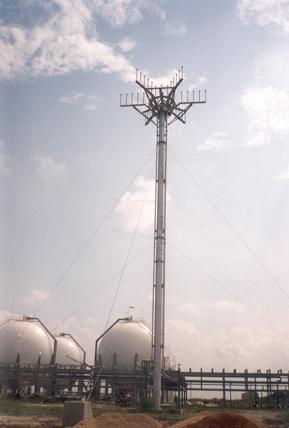
Equipment Design
Elevated flares are typically 100 to 500 feet tall so that the heat generated will not cause safety problems and for the reduction of noise. The combustion of gases occurs in the flare head.
All elevated flares contain similar types of secondary equipment to process the flue gas prior to being combusted. Mist eliminators and gravity settlers remove liquid from the gas stream. In the flare tip, a seal prevents dangerous air intrusion, an ignition system keeps the pilot lit, and equipment measures flow rates and temperatures. In addition, many flare systems contain equipment to eliminate smoke produced during combustion.
There are three types of elevated flare systems: guyed, derrick, and self-supporting, depending on the support structure.
Guyed stacks are the simplest and most economical flare system design. They take their name from the support wires, called guys. These flare systems can reach 400 feet tall, but require large amounts of land to accommodate the guys. The picture shows the pipe that brings the gas to the flare system and guy wire.
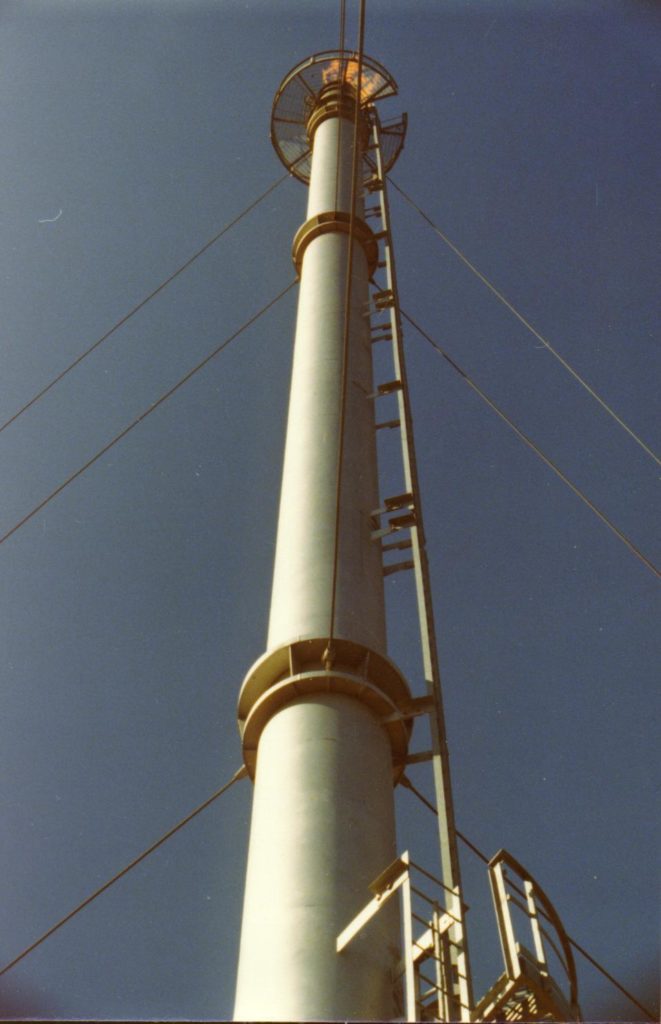
Derrick structures, such as the one pictured below, are common when the available land is small or thermal expansion is a concern. They offer greater support than guyed stacks but cost 50 to 100% more to build. The structure below allows individual flares to be mounted and dismounted for maintenance and repair without shutting down other flares in the system.
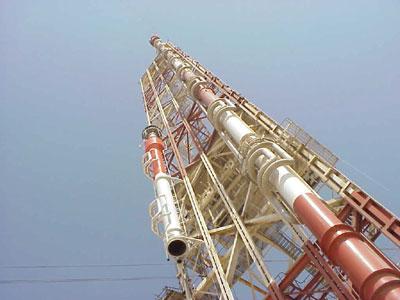

Most flare systems use only a single flare, but some use two. Two flares allow for separate flares for hot and cold gas streams, increasing efficiency.
Self-supporting flare systems have no wires or framework to support them. Instead, the material thickness is set to provide the desired strength, limiting the height to under 100 feet. Self-supporting flares can often be as economical as guyed flaring systems because they require little land and are simple to erect, reducing capital costs.
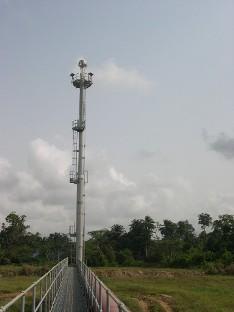
Usage Examples
Flare systems are found in every hydrocarbon processing facility and nearly every chemical processing plant. The petroleum industry uses flares in various operations, such as refineries and deep-sea ocean platforms. They are used to combust excess hydrocarbons into less harmful carbon dioxide before venting into the atmosphere. Pictured below is a fully smokeless flare system used by a major oil company.
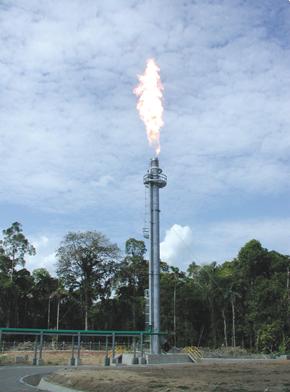
Advantages
- Destroy toxic, corrosive, and flammable vapors.
- Protect the environment and people in the vicinity of the plant.
- Can be made smokeless.
Disadvantages
- Costly.
- Produce no usable products.
- Can require a relatively large amount of land.
- Produce large amounts of noise, heat, and luminescence.
Ground
Ground flares combust exhaust gases to convert potentially toxic, corrosive, or flammable gases into less harmful products without the use of a stack or supports.
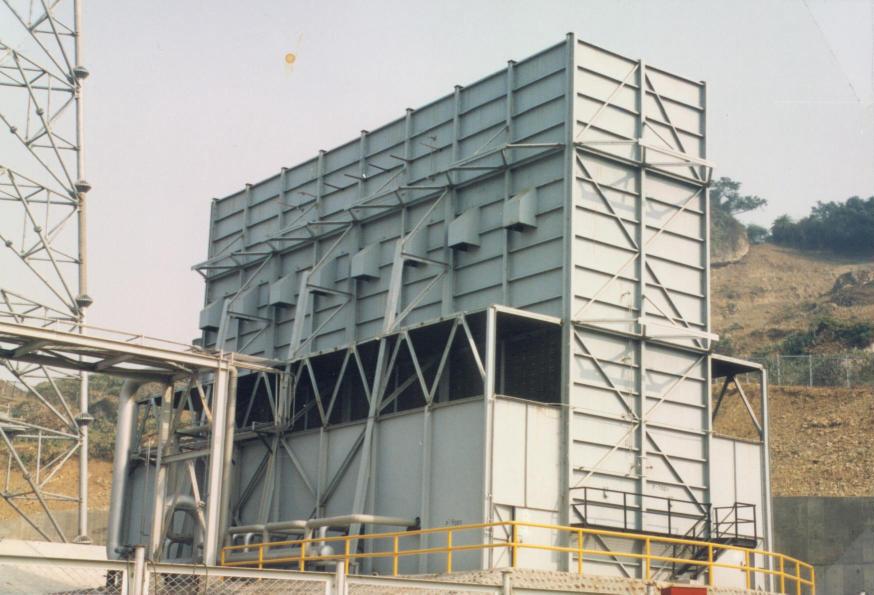
General Information
Ground flares come in two types, enclosed ground and open ground. Ground flares are close to the ground so they do not require supports or a stack like elevated flares do. Reducing the stack height allows pilots and other equipment, which can corrode, to be easily cleaned and replaced.
Equipment Design
Enclosed ground flares (EGF), such as the one pictured, are more common than open ground flares. A refractory shell (green in the picture) encloses the combustion process, shielding radiation, luminescence, and noise. Internally, EGFs work in the same way as an elevated flare.
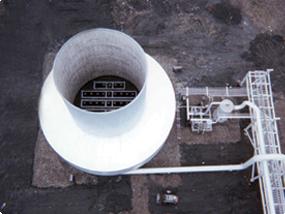
EGFs are much more expensive to purchase and install than elevated flares, but they are slightly cheaper to operate. They are limited in their handling capacity to between 50,000 and 250,000 lb/h, and are almost always smokeless. The picture below shows the inside of an EGF.
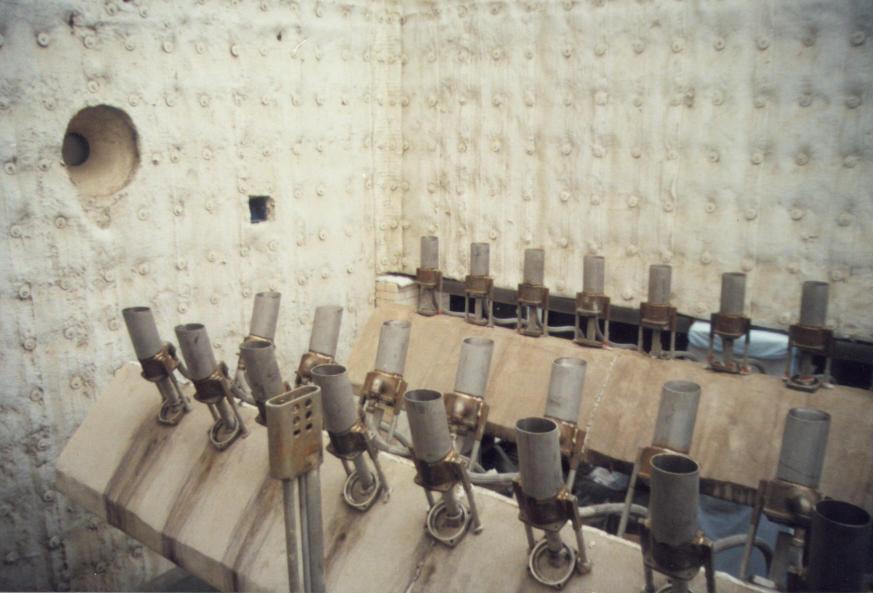
Open ground flares can come in many configurations. Most have multiple burners that combine to flare large amounts of gas, as seen in the photograph of a four-burner flare system. Open ground flares can combust much larger quantities of gas than EGFs, are nearly fully smokeless and achieve almost complete conversion of gases.
Open ground flares are limited by the space available to distribute burners, as they must be kept at a distance for safety reasons. In addition, they require gas at a pressure of 3-5 psig, which is much higher than all other types of flare systems. Open ground flares remove harmful products from the exhaust gas stream effectively but produce large amounts of noise, luminescence, and heat radiation, so they cannot be used where people may be disturbed or injured
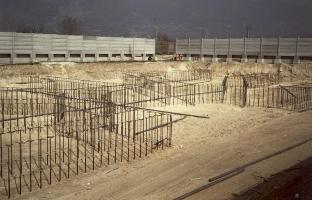
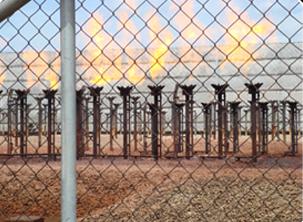
Usage Examples
Enclosed ground flares are used when heat, light, and noise must be controlled and safety is an issue. Open ground flares are useful when these are not concerns.
The enclosed ground flare pictured below is used on a floating production, storage, and offloading (FPSO) unit that is used for gas and oil extraction and treatment.

Advantages
- Closer to the ground, making repairs and cleaning easier.
- Lower operating costs than elevated flares.
- Enclosed flares block radiation, luminescence, and noise.
- Open flares can handle large amounts of gas.
- Almost fully smokeless.
Disadvantages
- Higher purchase and installation costs.
- Open flares have many safety issues.
- Open flares require high pressure.
- Enclosed flares have a limited flaring capacity.
Acknowledgement
- FLAREGAS Corporation, Nanuet, NY
- ThermoEngineering, Milano, Italy
- Zeeco, Inc., Broken Arrow, OK
References
- Cunha-Laite, Olavo. “Safety, Noise, and Emissions Elements Round Out Flare Guidelines.” Oil and Gas Journal Dec. 7, 1992: 68-74. Print.
- Cunha-Laite, Olavo. “Smokeless, efficient, nontoxic flaring.” Hydrocarbon Processing March 1991: 77-80. Print.
- Davis, B.C. “U.S. EPA’s Flare Policy: Update and Review.” Chemical Engineering Progress April 1985: 7-10. Print.
- Niemeyer, Christopher E. and Gerald N. Livingston. “Choose the Right Flare System Design.” Chemical Engineering Progress Dec. 1993: 39-44. Print.
- Vatavuk, William M. and Robert B. Neveril. “Flares and Flare System Design.” Encyclopedia of Chemical Processing and Design. 10th ed. 1985. Print.
Developers
- Daniel Viaches
- Christy Charlton
- Kelsey Kaplan
